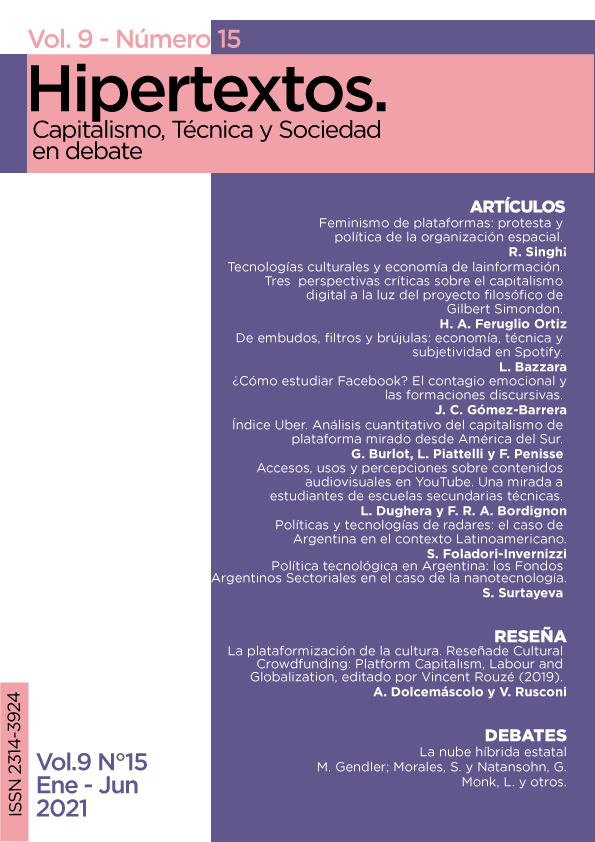Platform Feminism: Protest and the Politics of Spatial Organization
DOI:
https://doi.org/10.24215/23143924e026Keywords:
feminist activism, media platforms, politics, spatial organizationAbstract
This article brings into question the political utility of platforms as media for feminist resistance. Using examples of #MeToo, and the Women’s March on Washington, movements that have relied on the platform for reinvigorating what Sarah Banet-Weiser has called “popular feminism” (2018), I argue that common media platforms tend to infer an underlying assumption of safety, privilege and power in relation to social space. Through highlighting how BIPOC people organize in social space, I argue that the focus on amplification and elevation, facilitated by the logics of platform, obscures the needs of those who resist on the margins. I introduce the spatial strategies employed by those who must negotiate space differently to challenge the centrality of platforms as media the structure contemporary feminist protest.
Downloads
References
Baer, H. (2010). Redoing Feminism: Digital Activism, Body Politics, and Neoliberalism. Feminist Media Studies 16.1, p.17-34.
Banet-Weiser, S. (2018). Popular Feminism: #metoo. LA Book of Reviews.
Battersby, S. J. (2016, 2 de abril). Inside Toronto’s Black Lives Matter Camp.
The Toronto Star, https://www.thestar.com/news/gta/2016/04/03/inside-torontos-black-lives-mattercamp.Html
Bratton, B. H. (2015). The Stack: on Software and Sovereignty. MIT Press.
Brock, A. (2012). From the Blackhand Side: Twitter as a Cultural Conversation. Journal of Broadcasting and Electronic Media, 56:4, p.529-549.
Daniels, J. (2015). The Trouble with White Feminism: Whiteness, Digital Feminism and the Intersectional Internet, En Noble, S.U. and Tynes, B.M (eds), The Intersectional Internet: Race, Sex, Class and Culture Online. New York: Peter Lang Publishing.
Feigennbaum, A. (2014). Resistance Matters: Tents, Tear Gas and the ‘Other Media’ of Occupy. Communication and Critical/ Cultural Studies. 11-1, p.15-24.
Gajalla, R. (2012). Cyberculture and the Subaltern: Weavings of the Virtual and Real. Lexington Press.
Hands, J. (2013). Platform Communism. Culture Machine, 14, p. 1-24.
Hedge, R. S. (2011). Circuits of Visibility: Gender and Transnational Media Cultures. NYU Press.
Keller, J. (2012). Virtual Feminisms. Information, Communication & Society 15.3, p.429-47.
Kino-nda-niimi Collective (2104). The Winter We Danced: Voices from the Past, the Future, and the Idle No More Movement. Manitoba: ARP Books.
Langois, G. y Elmer, G. (2013). The Research Politics of Social Media Platforms. Culture Machine. Vol.14, p.1-17.
McLuhan, M. (1964). Understanding media. London: Sphere Books.
McPherson, T. (2014). Designing for Difference. Differences: A Journal of Feminist Cultural Studies, 25:1, p. 177-188.
Moss, P. y Maddrell, A. (2017). Emergent and divergent spaces in the Women’s March: the
challenges of intersectionality and inclusion. Gender, Place & Culture, 24:5.
Noble, S. U. y Tynes, B. M. (2015). The Intersectional Internet: Race, Sex, Class and Culture Online. New York: Peter Lang Publishing.
Packer, J. y Crofts Wiley, S. B. (2012). Communiction Matters: Materialist Approaches to Media, Mobility and Networks. Routledge.
Puar, J. (2015). Queer Times, Queer Assemblages. Social Text, 23, p.121–139.
Puar, J. (2011). ‘I would rather be a cyborg than a goddess’ Intersectionality, Assemblage, and Affective Politics. European Institute for Progressive Cultural Policies (Transversal: inventions).
Rentschler, C. (2015). #Safetytipsforladies: Feminist Twitter Takedowns of Victim Blaming. Feminist Media Studies 15.2, pp. 353-356.
Rottenberg, C. (2013, 13 de diciembre). Can #MeToo Go Beyond White Neoliberalism? Aljazeera http://www.aljazeera.com/indepth/opinion/metoo-white-neoliberal-feminism-171213064156855.html
Sharma, S. (2008). Taxis as Media: A Temporal Materialist Reading of the Taxicab. Social Identities: Journal of Race, Nation, and Culture, 14.4, p.457-464.
Srnicek, N. (2016). Platform Capitalism. Cambridge: Polity.
Sullivan, A. (2018, 12 de enero). It’s Time to Resist the Excesses of #MeToo. NY Mag. http://nymag.com/daily/intelligencer/2018/01/andrew-sullivan-time-to-resist-excesses-of-metoo.html
Taylor, A. (2014). The People’s Platform: Taking Back Power and Culture in the Digital Age. New York: Metropolitan Books.
Willoughby, V. (2017, 23 de enero). Signs At the Women’s March on Washington Called out White Feminism. Teen Vogue, https://www.teenvogue.com/story/signs-at-the-womens-march-on-washington-called-out-white-feminism

























